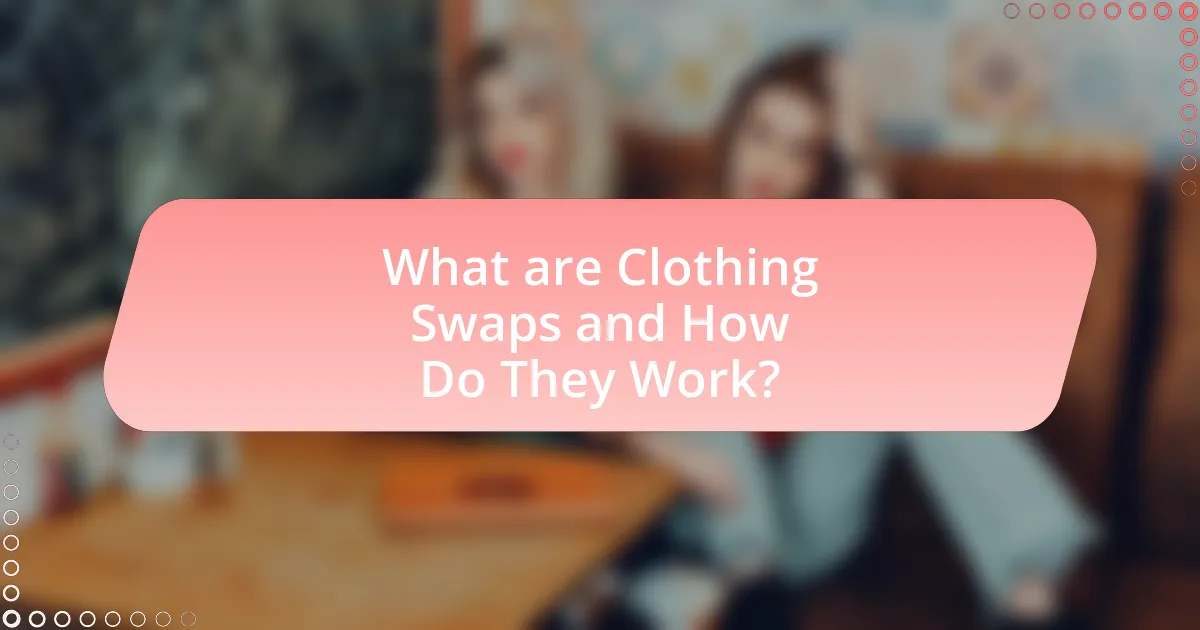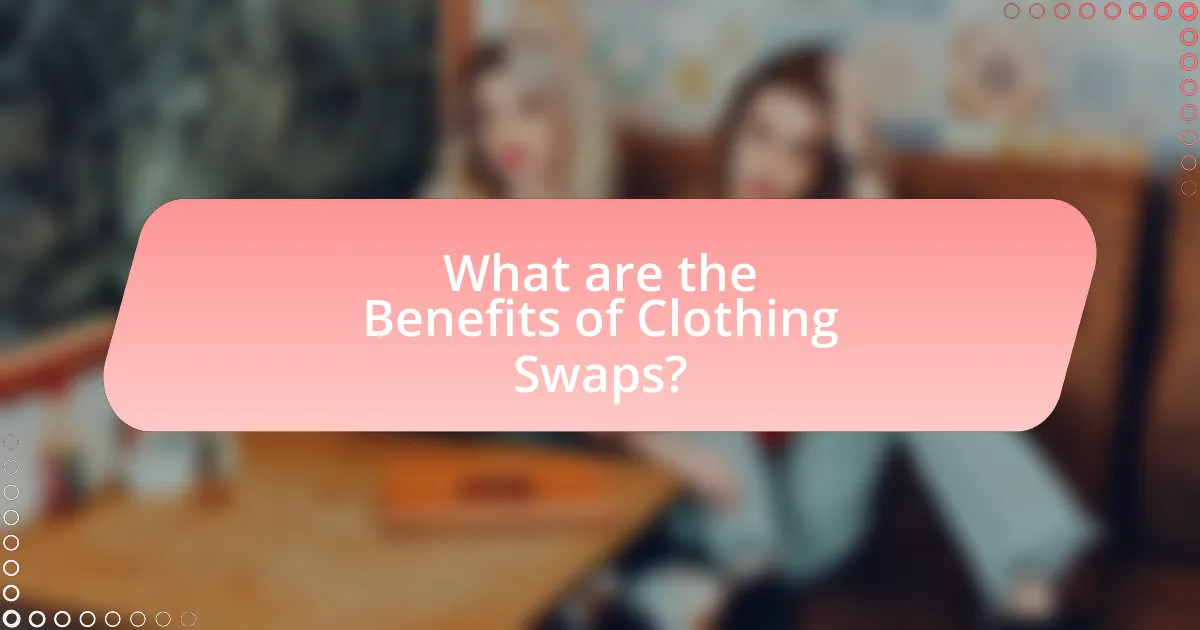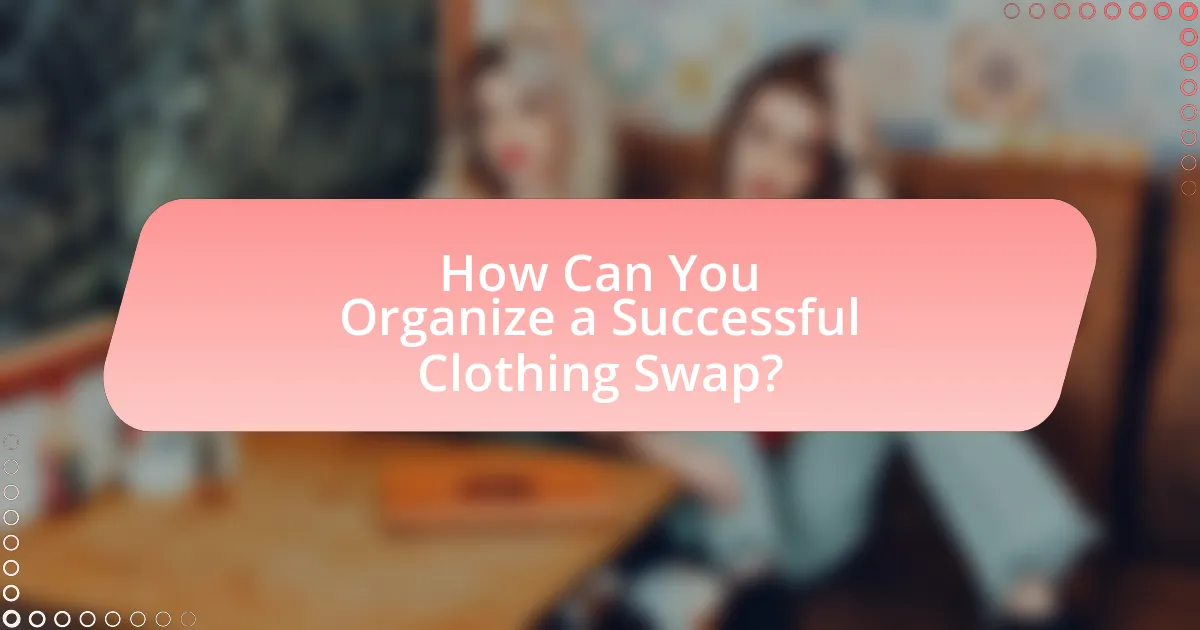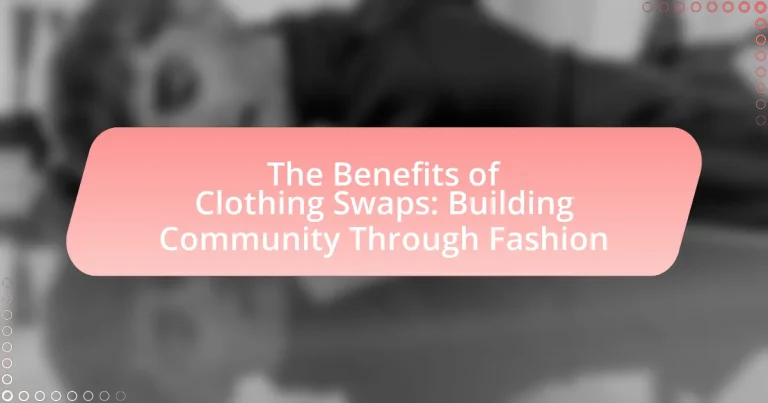Clothing swaps are events where individuals exchange unwanted clothing items, promoting sustainable fashion and community engagement. These gatherings allow participants to refresh their wardrobes without financial expenditure, significantly reducing textile waste and the environmental impact of fast fashion. The article explores the rising popularity of clothing swaps, the various types and formats they can take, and the social and environmental benefits they provide. Additionally, it outlines practical steps for organizing successful clothing swaps, addressing common challenges, and highlighting available resources for community support.

What are Clothing Swaps and How Do They Work?
Clothing swaps are events where individuals exchange their unwanted clothing items with others, promoting sustainable fashion practices. Participants bring their gently used clothes to a designated location, where they can browse and select items brought by others, effectively refreshing their wardrobes without spending money. This process not only reduces textile waste but also fosters community engagement, as it encourages social interaction and collaboration among participants. Research indicates that clothing swaps can significantly decrease the environmental impact of fashion consumption, as they extend the lifecycle of garments and reduce the demand for new clothing production.
Why are Clothing Swaps Gaining Popularity?
Clothing swaps are gaining popularity due to their sustainable approach to fashion and community building. As consumers become increasingly aware of the environmental impact of fast fashion, they seek alternatives that promote recycling and reduce waste. According to a 2021 report by the Ellen MacArthur Foundation, the fashion industry is responsible for 10% of global carbon emissions, prompting individuals to explore eco-friendly practices like clothing swaps. These events not only allow participants to refresh their wardrobes without spending money but also foster social connections, creating a sense of community among attendees.
What social and environmental factors contribute to the rise of Clothing Swaps?
Clothing swaps are rising due to increasing social awareness of sustainability and community engagement. The growing concern over fast fashion’s environmental impact, which contributes to 92 million tons of textile waste annually, drives individuals to seek alternatives like clothing swaps. Additionally, the desire for social interaction and community building fosters participation in these events, as they provide a platform for people to connect and share resources. This combination of environmental consciousness and social connectivity is pivotal in the popularity of clothing swaps.
How do Clothing Swaps differ from traditional shopping?
Clothing swaps differ from traditional shopping primarily in that they promote the exchange of garments among individuals rather than the purchase of items from a retailer. In clothing swaps, participants bring their unwanted clothing to trade with others, fostering a sense of community and sustainability. This method reduces waste and encourages recycling, as it allows for the reuse of clothing without financial transactions. Traditional shopping, on the other hand, typically involves monetary exchanges and often contributes to consumerism and environmental degradation. Studies indicate that clothing swaps can significantly lower the carbon footprint associated with fashion consumption, highlighting their environmental benefits compared to conventional retail practices.
What Types of Clothing Swaps Exist?
There are several types of clothing swaps, including community swaps, online swaps, themed swaps, and private swaps. Community swaps are organized events where individuals gather to exchange clothing, fostering local connections. Online swaps utilize platforms or social media to facilitate exchanges between participants who may not be geographically close. Themed swaps focus on specific categories, such as seasonal clothing or children’s wear, allowing for targeted exchanges. Private swaps occur among friends or family, providing a more intimate setting for sharing garments. Each type promotes sustainability and community engagement by encouraging the reuse of clothing.
What are the different formats for Clothing Swaps?
Clothing swaps can occur in various formats, including in-person events, online platforms, and hybrid models. In-person events typically involve participants gathering at a designated location to exchange clothing directly, fostering community interaction. Online platforms allow users to list items for swap, facilitating exchanges through shipping or local meet-ups. Hybrid models combine both in-person and online elements, enabling broader participation and flexibility. Each format promotes sustainability and community building by encouraging the sharing of resources and reducing waste.
How do community-based Clothing Swaps operate?
Community-based clothing swaps operate by allowing individuals to exchange unwanted clothing items with others in their community. Participants typically gather at a designated location, bringing their pre-owned garments to share. Each item is usually assessed for quality and appropriateness before being displayed for others to browse. The process encourages sustainable fashion practices by promoting reuse and reducing waste, as evidenced by studies showing that clothing swaps can significantly decrease the volume of textiles sent to landfills. Additionally, these events foster social connections and community engagement, as participants interact and share their fashion choices, enhancing the sense of belonging within the community.

What are the Benefits of Clothing Swaps?
Clothing swaps provide multiple benefits, including promoting sustainability, reducing waste, and fostering community connections. By participating in clothing swaps, individuals can extend the lifecycle of garments, thereby minimizing the environmental impact associated with fast fashion, which contributes to over 92 million tons of textile waste annually. Additionally, clothing swaps encourage social interaction and community building, as they create opportunities for people to meet, share fashion ideas, and exchange personal stories. This communal aspect enhances social ties and can lead to lasting friendships, making clothing swaps not only an eco-friendly choice but also a valuable social experience.
How do Clothing Swaps Foster Community Engagement?
Clothing swaps foster community engagement by creating a platform for individuals to connect, share resources, and promote sustainable practices. These events encourage social interaction as participants gather to exchange clothing, which not only facilitates the redistribution of fashion items but also strengthens local networks. Research indicates that community-driven initiatives like clothing swaps can enhance social cohesion, as they provide opportunities for people to meet others with similar interests and values, thereby fostering a sense of belonging. Additionally, clothing swaps often incorporate educational components about sustainability and responsible consumption, further engaging participants in meaningful discussions that benefit the community.
What role do Clothing Swaps play in building social connections?
Clothing swaps play a significant role in building social connections by creating opportunities for individuals to interact and engage with one another in a communal setting. These events foster a sense of community as participants share not only clothing but also stories, experiences, and personal styles, which enhances interpersonal relationships. Research indicates that social interactions during clothing swaps can lead to the formation of friendships and networks, as individuals bond over shared interests in fashion and sustainability. Furthermore, clothing swaps often attract diverse groups, promoting inclusivity and cultural exchange, which further strengthens social ties within the community.
How can Clothing Swaps enhance local community spirit?
Clothing swaps enhance local community spirit by fostering social connections and promoting sustainable practices. These events create opportunities for individuals to meet, share stories, and exchange clothing, which strengthens community bonds. Research indicates that community engagement activities, such as clothing swaps, can increase social cohesion and trust among participants. For example, a study published in the Journal of Community Psychology found that shared activities lead to improved relationships and a sense of belonging within neighborhoods. By participating in clothing swaps, individuals not only refresh their wardrobes but also contribute to a collective effort that reinforces community identity and collaboration.
What Environmental Benefits Do Clothing Swaps Provide?
Clothing swaps provide significant environmental benefits by reducing textile waste and minimizing the demand for new clothing production. By participating in clothing swaps, individuals extend the lifecycle of garments, which helps divert millions of tons of textiles from landfills. According to the Environmental Protection Agency, in 2018, approximately 11.3 million tons of textile waste were generated in the United States alone, highlighting the urgent need for sustainable practices. Additionally, clothing swaps decrease the carbon footprint associated with manufacturing, transporting, and disposing of new clothing, as the production of textiles is responsible for about 10% of global greenhouse gas emissions. Thus, clothing swaps contribute to a more sustainable fashion ecosystem by promoting reuse and reducing environmental impact.
How do Clothing Swaps contribute to sustainability?
Clothing swaps contribute to sustainability by reducing textile waste and promoting the reuse of garments. By facilitating the exchange of clothing among participants, these events extend the lifecycle of garments, thereby decreasing the demand for new clothing production, which is a significant contributor to environmental degradation. According to the Environmental Protection Agency, in 2018, approximately 11.3 million tons of textile waste were generated in the United States alone, highlighting the urgent need for sustainable practices like clothing swaps. Additionally, clothing swaps foster a sense of community and encourage mindful consumption, further supporting sustainable fashion practices.
What impact do Clothing Swaps have on reducing waste?
Clothing swaps significantly reduce waste by promoting the reuse of garments, thereby decreasing the demand for new clothing production. Research indicates that the fashion industry is responsible for 10% of global carbon emissions and a substantial amount of textile waste, with an estimated 92 million tons of textiles discarded annually. By participating in clothing swaps, individuals extend the lifecycle of clothing items, which helps mitigate these environmental impacts. A study published in the Journal of Cleaner Production found that swapping clothes can reduce the carbon footprint associated with clothing consumption by up to 50%. This practice not only diverts textiles from landfills but also fosters a culture of sustainability and community engagement.

How Can You Organize a Successful Clothing Swap?
To organize a successful clothing swap, start by selecting a suitable venue that can accommodate participants and their clothing items. Ensure the space is accessible and has enough room for sorting and displaying clothes. Next, set a date and promote the event through social media, community boards, and local networks to attract a diverse group of participants.
Establish clear guidelines for the swap, such as the number of items each person can bring and the types of clothing accepted, to maintain organization and quality. On the day of the event, create designated areas for different clothing categories, such as tops, bottoms, and accessories, to facilitate easy browsing.
Encourage participants to bring their friends to enhance community engagement, as studies show that social interactions during such events can strengthen community ties. Finally, consider incorporating additional activities, like refreshments or styling tips, to make the event more enjoyable and foster connections among attendees.
What Steps Should You Follow to Plan a Clothing Swap?
To plan a clothing swap, first, select a date and location that is accessible for participants. Next, create a guest list and invite individuals who are interested in swapping clothes. After that, establish guidelines for the swap, such as the number of items each person can bring and the condition of the clothing. Promote the event through social media or community boards to attract more participants. On the day of the swap, set up the space to display the clothing items clearly and organize them by category. Finally, facilitate the swapping process, ensuring everyone has a chance to browse and select items. These steps are essential for a successful clothing swap, fostering community engagement and sustainable fashion practices.
How do you choose a suitable venue for a Clothing Swap?
To choose a suitable venue for a Clothing Swap, prioritize accessibility, space, and amenities. The venue should be easily reachable by public transport and have sufficient room to accommodate participants and their clothing items comfortably. For instance, community centers or local parks often provide the necessary space and facilities, such as tables for sorting clothes and restrooms. Additionally, consider the venue’s atmosphere; a welcoming and vibrant environment encourages participation and fosters community engagement. Research indicates that well-organized events in accessible locations can increase attendance by up to 50%, highlighting the importance of venue selection in maximizing participation.
What strategies can you use to promote your Clothing Swap?
To promote your Clothing Swap, utilize social media platforms to create event pages and share engaging content that highlights the benefits of participating. Research shows that 72% of adults use social media, making it an effective tool for reaching a broad audience. Additionally, collaborate with local influencers or community groups to expand your reach and attract diverse participants. Hosting pre-swap events, such as styling workshops or informational sessions, can also generate interest and encourage attendees to invite friends. Engaging local businesses for sponsorship or partnerships can provide additional visibility and resources, enhancing the overall experience.
What Tips Can Ensure a Positive Experience for Participants?
To ensure a positive experience for participants in clothing swaps, organizers should prioritize clear communication and create an inclusive environment. Clear communication involves providing detailed information about the event, including guidelines for clothing quality, drop-off times, and the swapping process, which helps manage expectations and reduces confusion. Creating an inclusive environment means welcoming diverse participants and encouraging respectful interactions, fostering a sense of community. Research indicates that events promoting inclusivity and clear guidelines lead to higher participant satisfaction and engagement, as seen in community-building studies conducted by the Community Development Society.
How can you create a welcoming atmosphere at a Clothing Swap?
To create a welcoming atmosphere at a Clothing Swap, organizers should focus on inclusive communication and a friendly environment. Setting up a designated area for socializing, providing refreshments, and using clear signage can enhance the experience. Research indicates that social interactions foster community bonds, which is essential in a Clothing Swap setting. For example, a study by the University of California found that shared experiences, such as swapping clothes, can significantly improve social connections among participants.
What guidelines should participants follow to maximize their experience?
Participants should arrive with a clear understanding of the clothing swap’s rules and objectives to maximize their experience. Familiarizing themselves with the guidelines ensures a smooth exchange process and enhances community interaction. For instance, participants should bring high-quality, clean clothing items that they no longer wear, as this promotes a positive atmosphere and encourages others to engage. Additionally, being open-minded and respectful towards others’ choices fosters a welcoming environment, which is essential for building community connections. Engaging in conversations with fellow participants can lead to meaningful exchanges and friendships, further enriching the experience.
What Common Challenges Might Arise During a Clothing Swap?
Common challenges that might arise during a clothing swap include mismatched sizes, differing tastes among participants, and the potential for low participation rates. Mismatched sizes can lead to frustration, as individuals may bring items that do not fit others, limiting the effectiveness of the swap. Differing tastes can result in a lack of interest in the available clothing, as not all participants may appreciate the same styles or brands. Additionally, low participation rates can diminish the variety and quantity of items available, making the event less successful. These challenges can hinder the overall experience and benefits of community building through fashion.
How can you address issues of unequal participation?
To address issues of unequal participation in clothing swaps, organizers can implement inclusive strategies such as targeted outreach and diverse programming. By actively engaging underrepresented communities through tailored marketing efforts and partnerships with local organizations, organizers can ensure broader participation. Research indicates that inclusive practices, such as providing resources and support for marginalized groups, can significantly enhance engagement and participation rates. For instance, a study by the University of California found that events designed with community input saw a 40% increase in participation from diverse demographics.
What solutions exist for managing leftover clothing after the event?
Donating leftover clothing after an event is a primary solution for managing excess garments. Organizations such as Goodwill and Salvation Army accept donations, providing a tax deduction for donors and supporting community programs. Additionally, hosting a follow-up event for participants to reclaim items can ensure that clothing is redistributed among attendees. Research indicates that approximately 85% of textiles can be recycled or reused, highlighting the importance of responsible disposal methods. Furthermore, partnering with local charities can facilitate the collection and distribution of leftover clothing, ensuring that it benefits those in need while reducing waste.
What Resources Are Available for Organizing Clothing Swaps?
Resources available for organizing clothing swaps include online platforms, community centers, and local organizations. Online platforms such as Meetup and Facebook Events facilitate event planning and participant coordination. Community centers often provide space and resources for hosting swaps, while local organizations, including non-profits focused on sustainability, may offer support and promotional assistance. Additionally, guides and toolkits from environmental organizations, like the EPA, provide best practices for organizing successful clothing swaps, emphasizing community engagement and sustainability.
Where can you find community support for Clothing Swaps?
Community support for Clothing Swaps can be found through local organizations, social media groups, and community centers. Many cities have non-profit organizations that host clothing swap events, providing a platform for individuals to exchange clothing while fostering community connections. Additionally, platforms like Facebook and Meetup often have groups dedicated to sustainable fashion and clothing swaps, where members can share information about upcoming events. Community centers frequently organize swap events as part of their programming, encouraging local participation and engagement.
What online platforms can assist in organizing Clothing Swaps?
Online platforms that can assist in organizing clothing swaps include Meetup, Facebook Groups, and Swap.com. Meetup allows users to create events specifically for clothing swaps, facilitating local community engagement. Facebook Groups provide a space for individuals to connect and organize swaps within their local areas, leveraging existing social networks. Swap.com is an online marketplace that enables users to exchange clothing items, making the process of swapping more accessible and streamlined. These platforms enhance community building by connecting individuals with similar interests in sustainable fashion practices.


